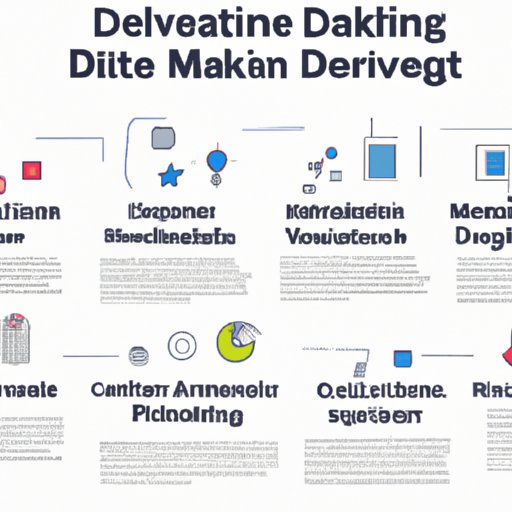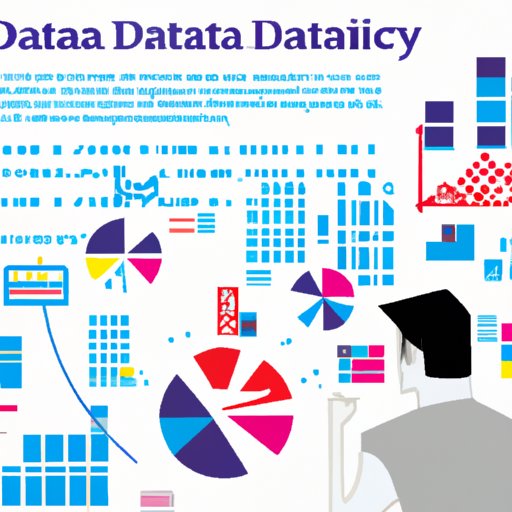Introduction
Data driven decision making (DDDM) is an approach to decision making that uses data to inform decisions. By using data to inform decisions, businesses can better understand their customers, optimize processes, and make decisions more quickly and accurately. In this article, we’ll explore the definition of DDDM, the benefits of using this approach, the best practices for implementing it, and some examples of successful DDDM.

Overview of Data Driven Decision Making
What is Data Driven Decision Making?
Data driven decision making is the practice of using data to inform business decisions. It involves collecting, analyzing, and interpreting data to gain insights that can be used to make informed decisions. The goal of DDDM is to use data to make decisions that are based on facts and evidence, rather than assumptions or intuition.
How Does Data Driven Decision Making Work?
Data driven decision making is a process that involves several steps. First, data must be collected from various sources. Then, the data must be organized and analyzed to gain insights. Finally, the insights must be interpreted and used to inform decisions. This process enables businesses to make decisions that are based on facts, rather than assumptions or intuition.
Best Practices for Data Driven Decision Making
Collecting and Organizing Data
The first step in any data driven decision making process is to collect and organize data from various sources. This can include data from internal systems, external sources, such as market research, or customer feedback. Once data is collected, it must be organized into a format that can be easily analyzed and interpreted.
Analyzing and Interpreting Data
Once data is collected and organized, it must be analyzed to gain insights. This can involve using statistical methods to identify trends or patterns in the data. After the data is analyzed, it must be interpreted to determine how it can be used to inform decisions. For example, if the data shows that a certain product is not selling well, the data can be used to inform decisions about how to improve the product.
Establishing a Clear Process for Decision Making
In order for data driven decision making to be effective, it is important to establish a clear process for decision making. This should involve setting objectives, developing a strategy, and defining criteria for success. This will help ensure that data is used effectively to inform decisions.

How to Implement a Data Driven Decision Making Process
Gather the Right Resources
In order to successfully implement a data driven decision making process, it is important to have the right resources. This includes having access to the necessary data, as well as having the skills and expertise to analyze and interpret the data. Additionally, it is important to have the right tools and technologies to support the data analysis process.
Set Clear Objectives
When implementing a data driven decision making process, it is important to set clear objectives. This includes determining what decisions need to be made and what data is needed to inform those decisions. Additionally, it is important to define the criteria for success so that it is clear when a decision has been successfully made.
Develop a Strategy
Once objectives have been established, it is important to develop a strategy for collecting, analyzing, and interpreting data. This should involve outlining the steps that need to be taken and identifying the resources that will be needed. Additionally, it is important to set timelines for each step so that progress can be tracked.
Common Challenges with Data Driven Decision Making
Inconsistent Data Quality
One of the most common challenges with data driven decision making is inconsistent data quality. This can occur due to errors in data collection or incorrect data entry. To address this challenge, it is important to ensure that data is collected accurately and that data entry processes are properly monitored and validated.
Lack of Time and Resources
Another challenge with data driven decision making is a lack of time and resources. Data analysis can be time consuming and requires specialized skills and expertise. To address this challenge, it is important to prioritize data analysis tasks and ensure that the right resources are available.
Difficulty in Interpreting Results
Finally, another challenge with data driven decision making is difficulty in interpreting results. Data analysis can produce complex results that may be difficult to interpret. To address this challenge, it is important to ensure that data is presented in a clear and concise manner and that the results are discussed in terms of how they relate to the decision at hand.

Examples of Successful Data Driven Decision Making
Amazon’s Use of Data to Improve Customer Experience
Amazon is a prime example of a company that uses data to inform decisions. Amazon collects and analyzes data on customer behavior and preferences to improve the customer experience. For example, Amazon uses data to personalize product recommendations, optimize website performance, and offer targeted discounts and promotions.
Walmart’s Use of Data to Optimize Supply Chain
Walmart is another company that uses data to inform decisions. Walmart uses data to optimize its supply chain by predicting demand, optimizing inventory levels, and improving delivery times. According to a study by Harvard Business Review, Walmart’s use of data has enabled them to reduce inventory costs by up to 25%.
Microsoft’s Use of Data to Enhance Productivity
Microsoft is a leader in using data to enhance productivity. Microsoft uses data to track employee performance and identify areas where improvements can be made. The company also uses data to develop new products and services, as well as to optimize marketing campaigns.
Conclusion
Data driven decision making is a powerful approach to decision making that uses data to inform decisions. By using data to inform decisions, businesses can make decisions that are based on facts and evidence, rather than assumptions or intuition. This article explored the definition, benefits, best practices, implementation strategies, and common challenges associated with data driven decision making.
(Note: Is this article not meeting your expectations? Do you have knowledge or insights to share? Unlock new opportunities and expand your reach by joining our authors team. Click Registration to join us and share your expertise with our readers.)
